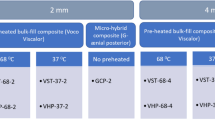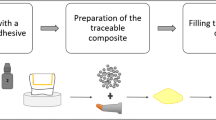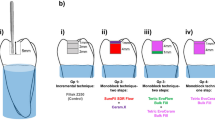Abstract
Objectives
This study evaluated the influence of cavity depth on polymerization shrinkage of bulk-fill resin composites with and without adhesive resin.
Materials and methods
Standardized box-shaped cavities (width, 4 mm; length, 5 mm, depth, 2 mm or 4 mm) were made on occlusal surfaces of extracted human third molars (N = 60). The teeth were assigned to 3 groups to receive bulk-fill resin composites (low-viscosity bulk-fill, SDR; high-viscosity bulk-fill; Filtek Bulk-Fill—FB; and TetricEvo Ceram Bulk-Fill—TB) in the prepared cavities with and without adhesive resin (Clearfil S3 Bond). Each specimen (n = 5 per group) was scanned twice using microcomputed tomography (micro-CT): once after application of the resin composite to the cavity prior to polymerisation and once after polymerisation. The shrinkage of volumetric loss (%) was measured using micro-CT. Data were analysed using Kruskal-Wallis and Mann-Whitney U tests (alpha = 0.05).
Results
The material type (p < 0.05), application of adhesive resin (p < 0.05) and cavity depth (p < 0.05) significantly affected the shrinkage values. The interaction terms were also significant (p < 0.05). All the bulk-fill resin composites tested showed significantly less shrinkage when applied in cavities with adhesive resin (0.94–2.55) compared with those without (2.01–3.45) (p < 0.05) and presented significantly more shrinkage after polymerisation (p < 0.05). At a 2-mm cavity depth without (2 mm, 2.28; 4 mm, 2.41) and with adhesive (2 mm, 0.94; 4 mm, 1.67), significantly less shrinkage was observed with FB compared with SDR and TB (p < 0.05). At a 4-mm cavity depth without (3.14) and with adhesive (2.55), SDR showed significantly higher shrinkage compared with FB and TB (p < 0.05).
Conclusions
The bulk-fill composites tested presented less shrinkage when used in conjunction with adhesive resin application on dentin. Overall, the low-viscosity bulk-fill resin SDR showed more shrinkage compared with high-viscosity resins tested.
Clinical relevance
Low- or high-viscosity bulk-fill resin composites should be applied on dentin after application of adhesive resin to decrease shrinkage.


Similar content being viewed by others
References
Bouillaguet S, Gamba J, Forchelet J, Krejci I, Wataha JC (2006) Dynamics of composite polymerization mediates the development of cuspal strain. Dent Mater 22:896–902
Silikas N, Eliades G, Watts DC (2000) Light intensity effects on resin-composite degree of conversion and shrinkage strain. Dent Mater 16:292–296
Krejci I, Planinic M, Stavridakis M, Bouillaguet S (2005) Resin composite shrinkage and marginal adaptation with different pulse-delay light curing protocols. Eur J Oral Sci 113:531–536
Panduric V, Demoli N, Tarle Z, Sariri K, Mandic VN, Knezevic A, Sutalo J (2007) Visualization of marginal integrity of resin-enamel interface by holographic interferometry. Oper Dent 32:266–272
Tsujimoto A, Barkmeier WW, Takamizava T, Latta MA, Miyazaki M (2017) Depth of cure, flexural properties and volumetric shrinkage of low and high viscosity bulk-fill giomers and resin composites. Dent Mater 36:205–213
Walter R (2013) Bulk-fill flowable composite resins. J Esthet Restor Dent 25:72–76
Elliot JC, Dover SD (1982) X-ray microtomography. J Microsc 126:211–213
Gambill JM, Alder M, del Rio CE (1996) Comparison of nickel-titanium and stainless steel hand-file instrumentation using computed tomography. J Endod 22:369–375
Rhodes JS, Ford TR, Lynch JA, Liepins PJ, Curtis RV (1999) Microcomputed tomography: a new tool for experimental endodontology. Int Endod J 32:165–170
Kuhn JL, Goldstein SA, Feldkamp LA, Goulet RW, Jesion G (1990) Evaluation of a microcomputed tomography system to study trabecular bone structure. J Orthop Res 8:833–842
Bergmans L, Van Cleynenbreugel J, Beullens M, Wevers M, Van Meerbeek B, Lambrechts P (2003) Progressive versus constant tapered shaft design using NiTi rotary instruments. Int Endod J 36:288–295
Sun J, Lin-Gibson S (2008) X-ray microcomputed tomography for measuring polymerization shrinkage of polymeric dental composites. Dent Mater 24:228–234
Kim HJ, Park SH (2014) Measurement of the internal adaptation of resin composites using micro-CT and its correlation with polymerization shrinkage. Oper Dent 39:57–716
Ilie N, Bucuta S, Draenert M (2013) Bulk-fill resin-based composites: an in vitro assessment of their mechanical performance. Oper Dent 38:618–625
Leprince JG, Palin WM, Vanacker J, Sabbagh J, Devaux J, Leloup G (2014) Physico-mechanical characteristics of commercially available bulk-fill composites. J Dent 42:993–1000
Kleverlaan CJ, Feilzer AJ (2005) Polymerization shrinkage and contraction stress of dental resin composites. Dent Mater 21:1150–1157
Ferracane JL, Mitchem JC (2003) Relationship between composite contraction stress and leakage in Class V cavities. Am J Dent 16:239–243
Calheiros FC, Sadek FT, Braga RR, Cardoso PE (2004) Polymerization contraction stress of low-shrinkage composites and its correlation with microleakage in Class V restorations. J Dent 32:407–412
Han SH, Park SH (2017) Comparison of internal adaptation in Class II bulk-fill composite restorations using micro-CT. Oper Dent 42:203–214
Gordan VV, Mjor IA (2002) Short- and long-term clinical evaluation of postoperative sensitivity of a new resin-based restorative material and self-etching primer. Oper Dent 27:543–548
Ilie N, Hickel R (2009) Investigations on mechanical behavior of dental composites. Clin Oral Investig 13:427–438
Cho E, Sadr A, Inai N, Tagami J (2011) Evaluation of resin composite polymerization by three dimensional micro-CT imaging and nanoindentation. Dent Mater 27:1070–1078
Moszner N, Fischer UK, Ganster B, Liska R, Rheinberger V (2008) Benzoyl germanium derivatives as novel visible light photoinitiators for dental materials. Dent Mater 24:901–907
Fronza BM, Rueggeberg FA, Braga RR, Mogilevych B, Soares LES, Martin AA, Ambrosano G, Giannini M (2015) Monomer conversion, microhardness, internal marginal adaptation, and shrinkage stress of bulk-fill resin composites. Dent Mater 31:1542–1551
Chiang YC, Röschb P, Dabanoglu A, Linc CP, Hickel R, Kunzelmanna KH (2010) Polymerization composite shrinkage evaluation with 3D deformation analysis from CT images. Dent Mater 26:223–231
Algamaiah H, Sampaio CS, Rigo LC, Janal MN, Giannini M, Bonfante EA, Coelho PG, Reis AF, Hirata R (2017) Microcomputed tomography evaluation of volumetric shrinkage of bulk-fill composites in class ii cavities. J Esthet Restor Dent 29:118–127
Papadogiannis D, Kakaboura A, Palaghias G, Eliades G (2009) Setting characteristics and cavity adaptation of low-shrinkage resin composites. Dent Mater 25:1509–1516
Zeiger DN, Sun J, Schumacher GE, Lin-Gibson S (2009) Evaluation of dental composite shrinkage and leakage in extracted teeth using X-ray microcomputed tomography. Dent Mater 25:1213–1220
Davidson CL, Feilzer AJ (1997) Polymerization shrinkage and polymerization shrinkage stress in polymer based restoratives. J Dent 25:435–440
Funding
The work was supported by TUBITAK (Grant number: 215S840), Turkey.
Author information
Authors and Affiliations
Corresponding author
Ethics declarations
Conflict of interest
The authors declare that they have no conflict of interest.
Ethical approval
This article does not contain any studies with human participants or animals.
Informed consent
Formal consent is not required for this type of study.
Additional information
Publisher’s note
Springer Nature remains neutral with regard to jurisdictional claims in published maps and institutional affiliations.
Rights and permissions
About this article
Cite this article
Ersen, K.A., Gürbüz, Ö. & Özcan, M. Evaluation of polymerization shrinkage of bulk-fill resin composites using microcomputed tomography. Clin Oral Invest 24, 1687–1693 (2020). https://doi.org/10.1007/s00784-019-03025-5
Received:
Accepted:
Published:
Issue Date:
DOI: https://doi.org/10.1007/s00784-019-03025-5




